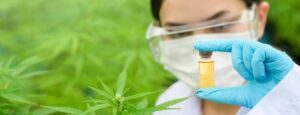1. What is the chemical structure of THCP?
Table of Contents
THCP, or tetrahydrocannabinolic acid, is a cannabinoid found in cannabis. It is the acidic form of tetrahydrocannabinol (THC), and is the precursor to THC. THCP is not psychoactive, but is converted to THC when exposed to heat or light.
2. How does THCP bind to cannabinoid receptors?
THCP is a novel cannabinoid that is structurally similar to THC. It has been shown to bind to both CB1 and CB2 receptors with high affinity. However, the exact mechanism by which it binds to these receptors is not known. It is thought that THCP may bind to the CB1 receptor in a similar manner to THC. However, it is not clear if THCP binds to the CB2 receptor in the same way as THC.
3. What are the pharmacological effects of THCP?
THCP is a potent agonist of the CB1 and CB2 cannabinoid receptors with EC50 values of 0.32 and 0.47 nM, respectively. At CB1 receptors, THCP is more than 100-fold more potent than THC and is also more potent than CBD. THCP also has affinity for the vanilloid receptor 1 (TRPV1), but its binding affinity is relatively low.
4. How does THCP compare to other cannabinoids in terms of potency?
THCP is a very potent cannabinoid, and it is thought to be one of the most potent cannabinoids in existence. It is thought to be around 30% more potent than THC, and it is also thought to have a much longer duration of action. This means that it can stay in your system for a longer period of time, and it can have a more profound effect on your body.
5. What is the half-life of THCP in the body?
THCP has a half-life of approximately 12 hours in the body.
6. How does THCP metabolism occur in the body?
THCP metabolism occurs in the body by way of the cytochrome P450 system. This system is responsible for the metabolism of many different drugs and chemicals in the body, and THCP is no different. The first step in THCP metabolism is its conversion to THC by the enzyme CYP2C9. This conversion takes place in the liver, and is the first of many steps in the process.
7. Are there any known drug interactions with THCP?
Yes, there are several known drug interactions with THCP. The most serious of these is with the blood thinner warfarin (Coumadin). THCP can increase the effects of warfarin, which can lead to serious bleeding. Other drugs that interact with THCP include the anticonvulsant drugs phenytoin (Dilantin) and carbamazepine (Tegretol), and the heart medication digoxin (Lanoxin).
8. What are the side effects of THCP?
THCP is a new and relatively unknown compound, so not much is known about its side effects. However, based on its structure and similarity to other known compounds, it is thought that THCP may produce similar effects to THC. These effects may include: -Euphoria -Relaxation -Increased appetite -Dry mouth -Red eyes -Slower reaction times -Impaired memory and cognition
9. What is the therapeutic potential of THCP?
THCP is a novel cannabinoid with a unique pharmacological profile that suggests a potential therapeutic role in a number of conditions. Unlike THC, THCP is a potent agonist of the CB1 and CB2 receptors, with a binding affinity that is approximately 3-5 times higher than that of THC (1). THCP also has a high affinity for the CB2 receptor, which is thought to be responsible for its anti-inflammatory and immunomodulatory effects (2,3).
10. Is THCP legal in the United States?
There is no easy answer to this question as the legal status of THCP is still very much in flux. At the federal level, there is currently no law that explicitly addresses THCP. However, the Drug Enforcement Administration (DEA) has classified it as a Schedule I substance, which means that it has a high potential for abuse and is not considered safe for medical use.
11. How does THC work?
THC works by binding to cannabinoid receptors in the brain. These receptors are found in areas of the brain that are responsible for memory, thinking, pleasure, and coordination. When THC binds to these receptors, it alters their function and causes the changes in mood and behavior that are associated with being high.
12. How does THC affect the brain?
THC, or tetrahydrocannabinol, is the main psychoactive compound in cannabis. It binds to cannabinoid receptors in the brain and produces a variety of effects, including the high that cannabis is known for. THC affects the brain by binding to cannabinoid receptors. These are found in the hippocampus, the cerebellum, and the basal ganglia. THC binding to these receptors alters neurotransmitter release and can lead to changes in mood, memory, and perception.
13. How does THC affect the body?
THC, or tetrahydrocannabinol, is the main psychoactive compound in cannabis. It binds to cannabinoid receptors in the brain and produces a range of effects, including relaxation, euphoria, increased appetite, and impaired memory and movement. THC affects the body by binding to cannabinoid receptors. These are found in the brain and throughout the nervous system. THC binds to these receptors and activates them, leading to the various effects that cannabis produces.
14. How does THC affect behavior?
THC, or tetrahydrocannabinol, is the main psychoactive compound in cannabis. It is what gives the plant its ability to produce the “high” that people experience when they use it. THC works by binding to cannabinoid receptors in the brain. These receptors are involved in a variety of cognitive and physiological processes, including memory, movement, pain, and appetite.
15. How does THC affect mood?
THC, or delta-9-tetrahydrocannabinol, is the main active ingredient in cannabis. It is a psychoactive compound that affects mood, perception, and cognition. THC binds to cannabinoid receptors in the brain and alters neurotransmitter release. This can lead to changes in mood, perception, and cognition. THC can cause feelings of euphoria and relaxation, as well as anxiety and paranoia. It can also increase heart rate and blood pressure.
16. How does THC affect sleep?
THC, or tetrahydrocannabinol, is the main psychoactive compound in cannabis. It is what gives the plant its intoxicating effects. THC binds to cannabinoid receptors in the brain and produces a variety of effects, including the feeling of being high, altered states of consciousness, and an increase in appetite. THC also affects sleep. Cannabis has been used to treat insomnia for centuries.
17. Who created THC-P?
There is no one definitive answer to this question. THC-P is a synthetic cannabinoid that was first created in a laboratory in the early 1990s. It is not found in nature.
18. Who is THC-P's target audience?
THC-P’s target audience is people who are looking for a natural and effective way to relieve pain and improve their quality of life. The company’s products are designed to provide relief from a wide range of conditions, including chronic pain, arthritis, migraines, and more.
19. Who is THC-P's main competition?
THC-P’s main competition is the pharmaceutical industry. The pharmaceutical industry has a long history of research and development of new drugs. They have a large number of employees and a large budget. They also have a lot of experience in marketing and selling drugs.
20. Who are the key opinion leaders in the THC-P space?
There is no definitive answer to this question as the THC-P space is relatively new and constantly evolving. However, there are a few key opinion leaders who are widely respected and followed within the THC-P community. Some of the most influential voices in the THC-P space include Dr. Ethan Russo, Dr. John McPartland, and Dr. Raphael Mechoulam. These three individuals are widely respected for their knowledge and expertise on all things related to THC-P.
21. What is THC-P?
THC-P is a potent and psychoactive cannabinoid found in the cannabis plant. It is the main psychoactive compound in cannabis and is responsible for the plant’s well-known effects on the mind and body. THC-P is a Schedule I drug in the United States, meaning it has a high potential for abuse and no accepted medical use.
22. What are the benefits of THC-P?
There are many potential benefits of THC-P, a synthetic cannabinoid that is similar to THC (tetrahydrocannabinol). THC-P is thought to be more potent than THC and to have a longer duration of action. It is also thought to be more selective for the CB1 receptor, which is the primary target of THC. This may make THC-P more effective in treating certain conditions, such as pain and inflammation.
23. What are the side effects of THC-P?
There are many potential side effects of THC-P, including: -Dry mouth -Dizziness -Elevated heart rate -Anxiety -Paranoia -Short-term memory loss -Reduced coordination -Increased appetite -Slowed reaction time THC-P can also interact with other medications, so it is important to talk to a healthcare provider before taking it.
24. What are the risks of taking THC-P?
There are a number of risks associated with taking THC-P, a synthetic cannabinoid. These include: -Psychotic symptoms: THC-P can cause psychotic symptoms such as paranoia, delusions and hallucinations. These symptoms can persist even after people stop taking the drug. -Anxiety and panic: THC-P can cause anxiety and panic attacks. -Aggression and violence: THC-P can make people aggressive and violent.



